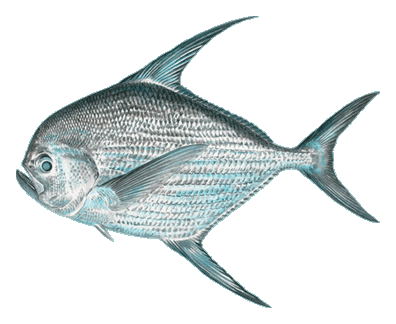
SICKLE POMFRET (MONCHONG)
Scientific Name: Taractichthys steindachneri
Hawaiian Name: Mukau
Japanese Name: Monchong; Hire Jiro Monchong
Two species of pomfret, also known as monchong in Hawaii are harvested in small quantities by the longline and bottomfish handline fisheries. The predominant species is the sickle pomfret, distinguished by the forked shape of its fins and large scales. The other, the lustrous pomfret accounts for less than 5% of monchong landings in Hawaii.
Monchong has a highly transparent, clear, white flesh with pinkish tones. It is firm in texture and moderate in flavor. It has a high oil content and good shelf life.
Monchong are landed and marketed fresh, sold at the Honolulu fish auction. Restaurants are the primary customers for monchong in Hawaii and the rest of the U.S.
Usually caught in deep waters (greater than 900 feet), often in the vicinity of seamounts. Monchong can range from about 4 pounds to over 25 pounds, but the prime market sizes are fish over 12 pounds.
FISHING METHOD
All Hawaii monchong are line-caught. Longline boats harvest most of the monchong catch in Hawaii. However, some monchong are also caught by deepwater handline gear with power reels.
SEASONALITY
There are no well-defined seasonal trends in availability.
PREPARATION NOTES
Texture: Firm
Flavor: Moderate
Suggested Preparations: Grilled, Broiled, Baked, Sautéed
Because of its high oil content, monchong is well suited for grilling but it can also be broiled, sauteed, baked, Tempura.
HEALTH & NUTRITION
Hawaii Sickle Pomfret is an excellent source of healthy, extra lean protein. It is also low in saturated fat and low in sodium. It is rich in niacin, vitamin B6, vitamin B12, phosphorus, and selenium. Hawaii Sickle Pomfret is a good source of iodine. Hawaii Sickle Pomfret also provides about 350 mg of omega-3’s (DHA and EPA) per 4 ounce serving of fresh fish. Click here for nutritional labels and claims.
Click here to download a two-page description of this species.

